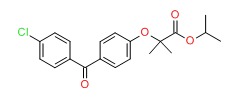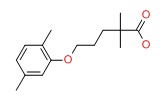NCBI Bookshelf. A service of the National Library of Medicine, National Institutes of Health.
LiverTox: Clinical and Research Information on Drug-Induced Liver Injury [Internet]. Bethesda (MD): National Institute of Diabetes and Digestive and Kidney Diseases; 2012-.

LiverTox: Clinical and Research Information on Drug-Induced Liver Injury [Internet].
Show detailsOVERVIEW
Fibrates are fibric acid derivative agents and are used to lower plasma lipids and particularly triglyceride levels. Chronic therapy with fibrates has been associated with transient mild elevations in serum aminotransferase levels and with rare instances of acute liver injury, which can be severe and evolve into chronic hepatitis, with progressive fibrosis and cirrhosis.
Fibrates are derivatives of fibric acid. Therapy with fibrates in humans leads to a lowering of serum very low density lipoprotein (VLDL) levels leading to decreases in triglyceride and cholesterol levels. Several fibrates have also been found to decrease low density lipoprotein (LDL) and increase high density lipoprotein (HDL) levels, but their effects are, in general, less than what can be achieved with the statins. The fibrates are currently used largely in patients with hypertriglyceridemia and are used in combination with statins to treat hypercholesterolemia.
The mechanism by which the fibrates lower lipid levels is unknown, but they may act through interactions with the hepatic peroxisome proliferator activated receptors (PPARs) which regulate gene transcription of enzymes involved in lipid synthesis and secretion. The fibrates bind specifically to a PPAR alpha isozyme, which is found largely in the liver and which regulates fatty acid oxidation, increasing lipoprotein lipase levels which, in turn, enhances clearance of triglyceride rich lipoproteins.
Three fibrates have been used in the United States: Gemfibrozil (Lopid: 1981), Fenofibrate (Lofibra, Tricor, Antara, Lipofen, Triglide: 1993), and Clofibrate (Abitrate, Atromid-S). Clofibrate has been withdrawn from use, largely because of concerns regarding increased risk of cancer and studies showing that, despite its cholesterol lowering activity, clofibrate therapy is not associated with a decrease in cardiovascular mortality. All three of the fibrates are associated with mild-to-moderate serum aminotransferase elevations during therapy that are typically transient, asymptomatic and may resolve even without discontinuation. All three agents have also been linked to cases of clinically apparent acute liver injury, fenofibrate most frequently and convincingly. The frequency and pattern of hepatic injury varies with the different fibrates and they do not appear to share a common pathway or class effect in causing liver injury. For these reasons each fibrate is discussed separately. The acute liver injury from the fibrates can be severe and prolonged and, unlike most forms of drug induced liver injury, can lead to chronic liver disease and cirrhosis.
Drug Class: Antilipemic Agents
Drugs in the Subclass, Fibrates: Clofibrate, Fenofibrate, Gemfibrozil
CHEMICAL FORMULAS AND STRUCTURES
| DRUG | CAS REGISTRY NUMBER | MOLECULAR FORMULA | STRUCTURE |
|---|---|---|---|
| Clofibrate | 637-07-0 | C12-H15-Cl-O3 |
 |
| Fenofibrate | 49562-28-9 | C20-H21-Cl-O4 |
 |
| Gemfibrozil | 25812-30-0 | C15-H22-O3 |
 |
- PubChem SubstanceRelated PubChem Substances
- Review Antilipemic Agents.[LiverTox: Clinical and Researc...]Review Antilipemic Agents.. LiverTox: Clinical and Research Information on Drug-Induced Liver Injury. 2012
- Review Mechanism of action of fibrates on lipid and lipoprotein metabolism.[Circulation. 1998]Review Mechanism of action of fibrates on lipid and lipoprotein metabolism.Staels B, Dallongeville J, Auwerx J, Schoonjans K, Leitersdorf E, Fruchart JC. Circulation. 1998 Nov 10; 98(19):2088-93.
- Review Fibric acids: effects on lipids and lipoprotein metabolism.[Am J Med. 1987]Review Fibric acids: effects on lipids and lipoprotein metabolism.Grundy SM, Vega GL. Am J Med. 1987 Nov 27; 83(5B):9-20.
- Review Role of fibric acid derivatives in the management of risk factors for coronary heart disease.[Drugs. 2004]Review Role of fibric acid derivatives in the management of risk factors for coronary heart disease.Després JP, Lemieux I, Robins SJ. Drugs. 2004; 64(19):2177-98.
- Review [Mechanisms of actions of statins and fibrates].[Therapie. 2003]Review [Mechanisms of actions of statins and fibrates].Duriez P. Therapie. 2003 Jan-Feb; 58(1):5-14.
- Fibrates - LiverToxFibrates - LiverTox
Your browsing activity is empty.
Activity recording is turned off.
See more...